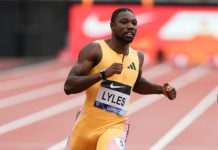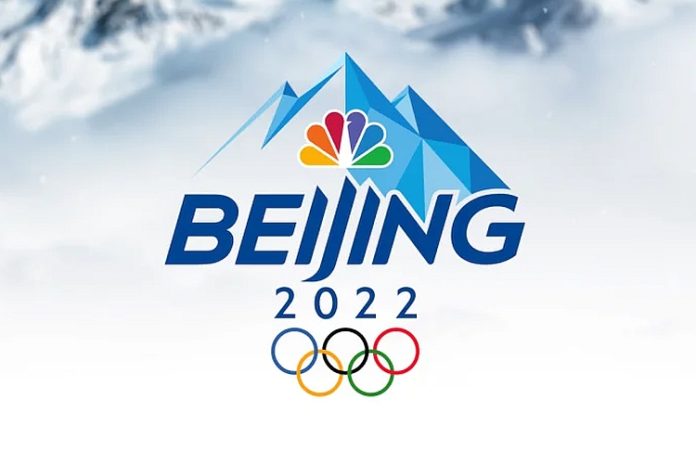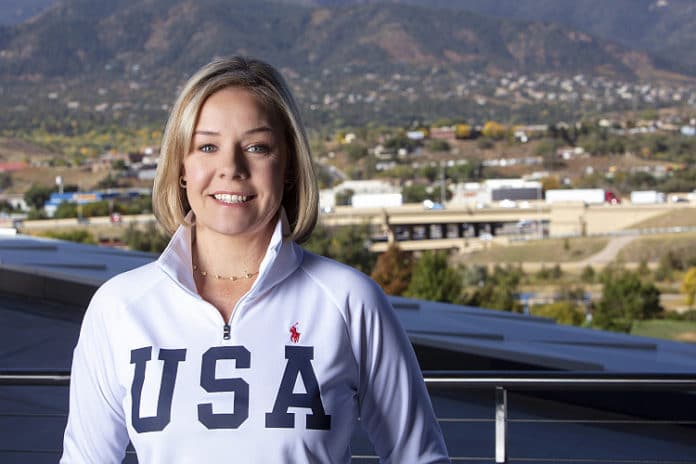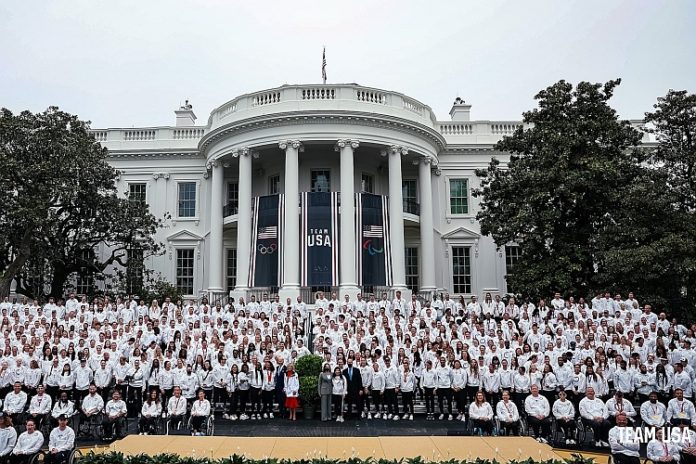● Plus: IOC: TOP sponsor Airbnb offering second year of $2,000 grants = On Screen: Penn Relays draws modest TV audience = Los Angeles 2028: New $30 million cricket stadium coming to Irvine, a boost for 2028 inclusion = Basketball: U.S. State Dept. changes to more active status on Griner detention = Boxing: European confederation elects new board, including one Russian = Figure Skating: ‘88 Pairs bronze winner Oppegard suspended by SafeSport = Football: UEFA bans Russian teams; FIFA reports 49 national federation sanctions in first quarter; Infantino urges investment in ‘26 World Cup legacy = Swimming: Three-event World Cup schedule revealed, with one in Indianapolis = AT THE BUZZER: Columbia and LA28 partner for intern training through 2028 ●
News, views and noise from the non-stop, worldwide circus of Olympic sport:
≡ SPOTLIGHT ≡
The Beijing 2022 Olympic Winter Games was a big hit in Canada. The Canadian Broadcasting Corporation reported that 70% of all Canadians watched some part of the Games and 50% watched an average of 102 minutes in primetime during the 15 full days of competition.
In the U.S., NBC reported a nightly primetime average of 11.6 million viewers (3.4% of the population) and that 160 million Americans (48%) watched some part of the Games. Tokyo wasn’t a lot better.
So is the U.S. Olympic & Paralympic Committee worried?
Yep.
Says USOPC chief executive Sarah Hirshland, “There’s work to do on that. And it is a top priority.”
During an hour-long Monday interview, Hirshland explained the USOPC’s new structure and then expanded on the vision for the future developed by the Board and staff:
● “The first thing I want to talk about is the notion of athlete excellence and performance, because that is critical and foundational to our mission and to who we are, and will be a very important priority as we go forward.
“Part of this work is about how we continue to invest in, and innovate in, holistic human performance. And that’s a big area of focus and will continue to be a big area of focus. The integration of functions under this new Chief of Sport and Athlete Services is all about that. How are we leveraging technology and innovation to continue to drive performance, how are we thinking about the efficiency of the dollars we invest and where we invest them to drive performance, how do we take advantage of synergies across National Governing Bodies and across sports to really able to continue to drive that holistic, human and athletic performance.
“So that’s a first area that’s really, really important,. It’s not lost on us that the rest of the world is making significant investments in their athletic programs and while we have had great success, particularly in the summer Olympic Games, and some growing success in other areas; we’re not where we want to be, and so we’ve got work to do there and sometimes it is both about improving your position and, if you’re in the position at the top, holding that position is something you can’t take for granted, and we don’t take any of that for granted.
“So, it’s really important and it has to be first on the list.”
● “Number two is really about sport advancement, and that is, to a degree, about insuring that we’re focused on the integrity of sports, that we’re creating a fair, safe and inclusive environment where sport can thrive and that includes effective and successful National Governing Bodies and continued support to fight doping, issues of that nature and really making sure that we don’t lose sight of sport in this country and the advancement, efficiency and effectiveness of sport administration.”
● “A third area is community growth … We know that we are a movement that takes massive, massive support and has had – and continues to have – incredible support from many areas, not the least is the corporate community, the broadcast and content community, and the donor community, all of which are absolutely essential to our success.
“And we are concerned about the trend that you referenced, and the massively-changing consumption habits in our country in particular, around television, around cable television, around streaming, around social media and how to reach audiences. The game is just different today. It used to be we lived in a world which the Olympics was appointment viewing, as you know, and you could go to one place and navigate your way to find all the things you wanted to find, and we don’t live in that world any more. And so there has to be an evolution of how we think about allowing audiences to choose when and how they are going to interact with the Games in very, very different ways and for different reasons.
“And so there is a lot of time and energy and conversation that is happening with our partners at NBC around how we think about the future of telling these stories and content consumption and different mechanisms to do that through a variety of different channels. It’s critically important and we have to continue to engage the American consumer – by the way, at all ages and in all places – and we’re not where we want to be on that.”
Hirshland also spoke a little about leadership, tactics and bringing more folks to help with the push to re-design how the Games can regenerate a higher profile:
“The key on this one is actually a blend between what will be our Strategy and Growth group, under Katie Bynum’s leadership, and [U.S. Olympic & Paralympic Properties] and LA28 [organizing committee]. Partially because, the natural evolution of telling stories is in many ways fueled by the support of the sponsorship and licensing community, and, as we’re delivering value, delivering content is a piece of that value, more today than it ever was. …
“The more integrated we become in working with the corporate community and the content distribution community – whether that’s NBC or social channels or other channels – we can make one-plus-one equal three, to use a very old cliche, but an important way to think about.
“And we’re also asking the [International Olympic Committee] to join us at that table and be thoughtful about what role they can and will play as they become a more-flat organization whose also focused on their own reputation and brand and how they are supporting the continued evolution of what the Rings stand for.
“So, yes, I would call it an ‘interdisciplinary task force’ if you want to use those words, because there are a lot of us who have a vested interest in this at all levels. And so we’re all sitting at the table and how to best work together to accomplish what we need to.”
Hirshland also spoke to today’s marketing efforts that involve social media, a much different way to touch Americans than the direct-mail programs so widely – and effectively – used by the USOC’s marketing programs of the 1990s:
“I think the important thing to understand, too, is it’s not moving from direct mail to social media per se, because it’s just a proliferation of channels and a proliferation of voices.
“So promoting the Olympic Movement may have been the USOC in the ‘90s, and today, there are 500 athletes whose voices are as loud as many others, and so their voices matter enormously as well and that’s the challenge that we’re all facing, is figuring out how to navigate that. In many ways there are advantages and in many ways there are disadvantages and challenges with it, but it is a very different landscape and a very different marketplace.
“But the ability to touch Americans is easier now than it has ever been in concept. In execution is where you have to really be thoughtful about how to get that right, and make sure that the touches they’re getting have enough consistency to have the impact you want.”
As she noted, much easier said than done. Hirshland also sees the challenge ahead as the long-time structure of collegiate sport – on which the USOPC has been historically dependent – continues to implode:
“The NCAA has had, and I think will continue to have, an important role to play in ‘national championships’ and collegiate championships. … The NCAA is sort of organized by the life-cycle stage of an athlete in terms of, you may go through youth sports, and then to high school sports and then you get into college sports and maybe you graduate into professional or elite sport.
“And our ecosystem is organized by sport: vertical, right? USA Volleyball takes young volleyball players all the way through the most elite. And so how do we almost bring the horizontal and the vertical lines a little closer together as we think about the athlete experience? The conversation that we’re having in some very real ways, and the championships and the role of NGBs in sport governance and in competitions is something we’re poking around at quite a bit. …
“It has the potential to impact the upstream of sport – and elite sport – as it relates to Team USA and the NGBs and it will certainty impact the downstream of sport, and youth sport participation and neither of those things is good for this country.”
The NCAA’s rule changes on name, image and likeness are re-shaping collegiate sport in a confusing way; Hirshland noted that the USOPC is continuing to look at its own ways of funding athletes and helping them fund themselves:
“We’ll always look at growth in our own, what we call, Direct Athlete Support – the stipends that we grant to athletes now – and we’ll continue to look at that. It’s grown consistently over time and especially the last few years … and it’s worth noting, we’re not the only ones providing stipends; sometimes, NGBs are also adding their own support, direct support for athletes. …
“We will continue to take a look at things like [Operation Gold], which is our reward component for medals and/or World Championship wins and things of that nature, and we’re looking at how do we continue to empower athletes to generate earnings from other sources.
“We launched the Athlete Marketing Platform, and are building capacity for athletes to leverage their own name, image and likeness. We’re doing a lot of training around how to understand their intellectual property, how to capitalize on that intellectual property and then trying to create a marketplace for them to do that.
“As you know, the vast, vast, vast majority of our athletes don’t have agent representation and don’t have someone to help them field that marketplace, so this is a technology solution aimed to try to do more of that, and we will continue to think about that.
“I’m here today in Washington, D.C., where we have an Athlete’s Summit and this afternoon, there’s a bunch of breakout sessions, and those breakout sessions are also about how to build your brand … We live in a world now where ‘the gig economy’ is real and athletes have opportunities to earn revenue in ways that they frankly just didn’t used to, that doesn’t disrupt their training nearly as much, or at all., So part of our focus is also on how do we educate and teach and train behaviors that can enable earnings both from the corporate community, the endorsement community, speaking, appearances, things of that nature, as well as think about stipends and funding coming from our organization as well as balancing where some NGBs have the capacity to do that, and some don’t. So it’s a blend.
“I will also say there are absolutely case studies and incidents where NIL in collegiate sport has also been enormously helpful for some of our athletes. Not all, by any stretch, but a good portion of the delegation are currently-competing collegiate athletes, or are planning to go to college, and so the opportunity for them to capitalize on their name, image and likeness while they are in college, is a huge shift and it’s proving in several cases to be quite advantageous to Team USA.”
Wednesday’s White House ceremony for the Tokyo and Beijing teams was months in the making and will be enormous:
“So, we’ve been excited. We talked even in advance of Tokyo about the notion of the best way to do this was rather than try to bring a delegation in between these two Games, to do it all together at the end of the two Games, and that’s where we find ourselves now and we’re really excited.
“The Administration has been really wonderful to work with, frankly, in planning what will be the largest White House visit ever by Team USA. So it is a logistical challenge for all of us, of course, but we’ve got a great group and hopefully the weather will hold out and we’ll have a great celebration outside. If not, we’ll have to move inside.
“I believe we have about 650 Team USA athletes, and with guests that have been invited – both by us and by the Administration directly – I think we’re expecting about 3,000 folks.”
After the challenges of getting through the Covid restrictions of Tokyo and Beijing, getting in and out of Washington, D.C. should be no problem for the USOPC. But Hirshland and her team will face a lot of challenges once the smiling stops and the work in Colorado Springs begins again.
≡ THE 5-RING CIRCUS ≡
● International Olympic Committee ● TOP sponsor Airbnb is again offering an opportunity to apply for a $2,000 Athlete Travel Grant:
“The initiative launched in 2021 to provide athletes with added flexibility and funding, supporting them with travel costs in a year severely impacted by the COVID-19 pandemic. USD 8 million of funding has been allocated to run the programme for nine years in total, with up to 500 athletes selected each year.”
The grant can be used at Airbnb properties all over the world. Per the announcement:
“Applications for the Airbnb Athlete Travel Grant are open to all elite athletes, Olympians, Paralympians and hopefuls until 20 May 2022, more information can be found via the Athlete365 platform.”
● On Screen ● The Penn Relays telecast on ESPN2 last Saturday drew a television audience of 225,000, the only Olympic-sport event to draw an audience of more than 200,000 last week.
None of the five days of telecasts of USA Swimming’s Phillips 66 International Team Trials in Greensboro on NBC’s Olympic Channel (4 days) and CNBC (1 day) were reported in the top 150 cable programs each day. Neither was the CBS Sports Network’s coverage of the Drake Relays on Saturday.
The week’s leading sports show was the first night of the NFL Draft on ESPN and ABC, with 10.031 million viewers. The second night of the Draft drew 5.690 million.
● Games of the XXXIV Olympiad: Los Angeles 2028 ● Cricket’s push to be included in the LA28 Games is a long shot, but was given a boost by Sunday’s announcement that a 10,000-seat cricket stadium is to be built in Irvine, California.
The Knight Riders Group, owners of the Indian Premier League franchise Kolkata Knight Riders and Trinbago Knight Riders (TKR) in the Caribbean Premier League, is backing the $30 million project in cooperation with Major League Cricket.
The LA28 venue plan does have an Orange County site, with the Honda Center slated to host volleyball in Anaheim, so a venue in Irvine would not be an orphan.
● Basketball ● A major change by the U.S. State Department in its view of the continuing detainment of two-time Olympic gold medalist Brittney Griner.
CNN reported “The State Department has now classified WNBA star Brittney Griner as wrongfully detained in Russia and her case is being handled by the office of the US Special Presidential Envoy for Hostage Affairs (SPEHA) Roger Carstens.”
The change in status is expected to see the State Department more actively trying to negotiate Griner’s release; she was arrested on 17 February and has a hearing reportedly scheduled for 19 May.
The WNBA said it would add a floor decal with Griner’s initials and no. 42 to all courts this season as a reminder of her situation.
● Boxing ● The European Boxing Confederation elected new officers and directors last Saturday, with Dr. Ioannis Filippatpos (GRE) elected as President.
Of interest among the nine members of the Board is Russian Sumayd Khalidov, who has been active on AIBA committees. It will be interesting to see if this is noticed by the IOC, continuing to consider whether the sport should be on the program for Los Angeles 2028.
● Figure Skating ● The U.S. Center for SafeSport suspended American skating coach Peter Oppegard for “physical and emotional” misconduct on Monday, but provided no further details.
A USA Today story explained that Oppegard is alleged to have bitten 15-year-old skater Jessica Pfund during a practice session in 2013. An investigation was not opened until 2020 and other instances of misconduct have been alleged.
Oppegard was an Olympic bronze medal in Pairs skating with Jill Watson at Calgary in 1988, won three national championships and has been a longtime coach, mostly in Southern California.
● Football ● The European Football Union (UEFA) announced Monday that Russian teams are banned from almost every competition, including the Nations League, European U-21 Championship, Women’s EURO 2022 and from the qualification process for the 2023 FIFA Women’s World Cup. The Russian team which had qualified for the Women’s EURO 2022 will be replaced by Portugal.
Further, “Russia will have no affiliated clubs participating in UEFA club competitions in the 2022/23 season,” which include the UEFA Champions League, UEFA Europa League, UEFA Europa Conference League, UEFA Women’s Champions League and UEFA Youth League.
The Football Union of Russia bid for the 2028 or 2032 European Championship was declared ineligible, according to Article 16.02 of the Bid Regulations UEFA Finals and Final Phases, including:
“each bidder shall ensure that it does not act in a manner that could bring UEFA, the UEFA final or UEFA final phase, any other bidder (or any employee, officer or representative of any of the foregoing), the bidding procedure or European football into disrepute.”
The Russian Football Union is considering an appeal to the Court of Arbitration for Sport.
¶
FIFA posted its disciplinary sanctions list for the first quarter of 2022, with 49 entries, with Mexico and Venezuela both hit three times, each with modest fines.
The biggest sanctions:
● Senegal: A fine of CHF 175,000 and one match without spectators for an offensive fan banner, throwing of objects, lighting of fireworks, use of laser pointers against players and more in the 29 March game vs. Egypt.
● Nigeria: A fine of CHF 150,000 and one match without spectators for failures in security in the stadium vs. Ghana on 29 March.
● Dem. Rep. of the Congo: A fine of CHF 120,000 and limited spectators for one match after a fan security breakdown in the 25 March match against Morocco.
● Lebanon: A fine of CHF 100,000 and one match without spectators for security lapses vs. Syria on 24 March.
● Chile: A fine of CHF 80,000 and limited spectators for one match after team misconduct, discriminatory behavior by spectators and throwing of objects by spectators from the 27 January match vs. Argentina.
● El Salvador: A fine of CHF 80,000 and limited spectators for one match due to fans throwing objects and having a drone flying inside the stadium vs. Costa Rica on 27 March.
The U.S. got one sanction, and a fine of CHF 5,000 for “invasion of the field of play” at the game vs. El Salvador on 27 January, in Columbus, Ohio.
¶
Speaking at an investment conference in Los Angeles, FIFA President Gianni Infantino emphasized the legacy opportunities and potential attached to the 2026 FIFA World Cup that will be held in Canada, Mexico and the U.S.
“We have to find other ways to touch the hearts and the emotions of people.
“I think there are different ways of doing that, and we want to use the opportunity of this FIFA World Cup coming here. The first level is really the grassroots level; it’s the access to the sport. We have to give boys and girls, children, easier access to the sport.”
● Swimming ● Swimswam.com reported on the 2022 FINA World Cup schedule, to be shortened to three meets, in Berlin (21-23 October), Toronto (28-30 October) and Indianapolis (3-5 November).
The meets will be in held in 25 m pools; the last time the U.S. hosted a World Cup meet was in 2006. An Indianapolis World Cup was held in the first year of the series in 1988-89.
≡ AT THE BUZZER ≡
Columbia University’s Sports Management Graduate Program added to its partnership agreements with major sporting organizations with a six-year project with the LA28 Olympic and Paralympic Games Organizing Committee.
The program will include two internships per year for Columbia students and begin in the spring of 2022, running right through the 2028 Games.
Columbia has also developed programs with the National Football League and multiple football partners including FC Bayern Munich, La Liga North America, Real Madrid and NYCFC of the MLS.
You can receive our exclusive TSX Report by e-mail by clicking here. You can also refer a friend by clicking here, and can donate here to keep this site going.
For our updated, 620-event International Sports Calendar for 2022 and beyond, by date and by sport, click here!




























